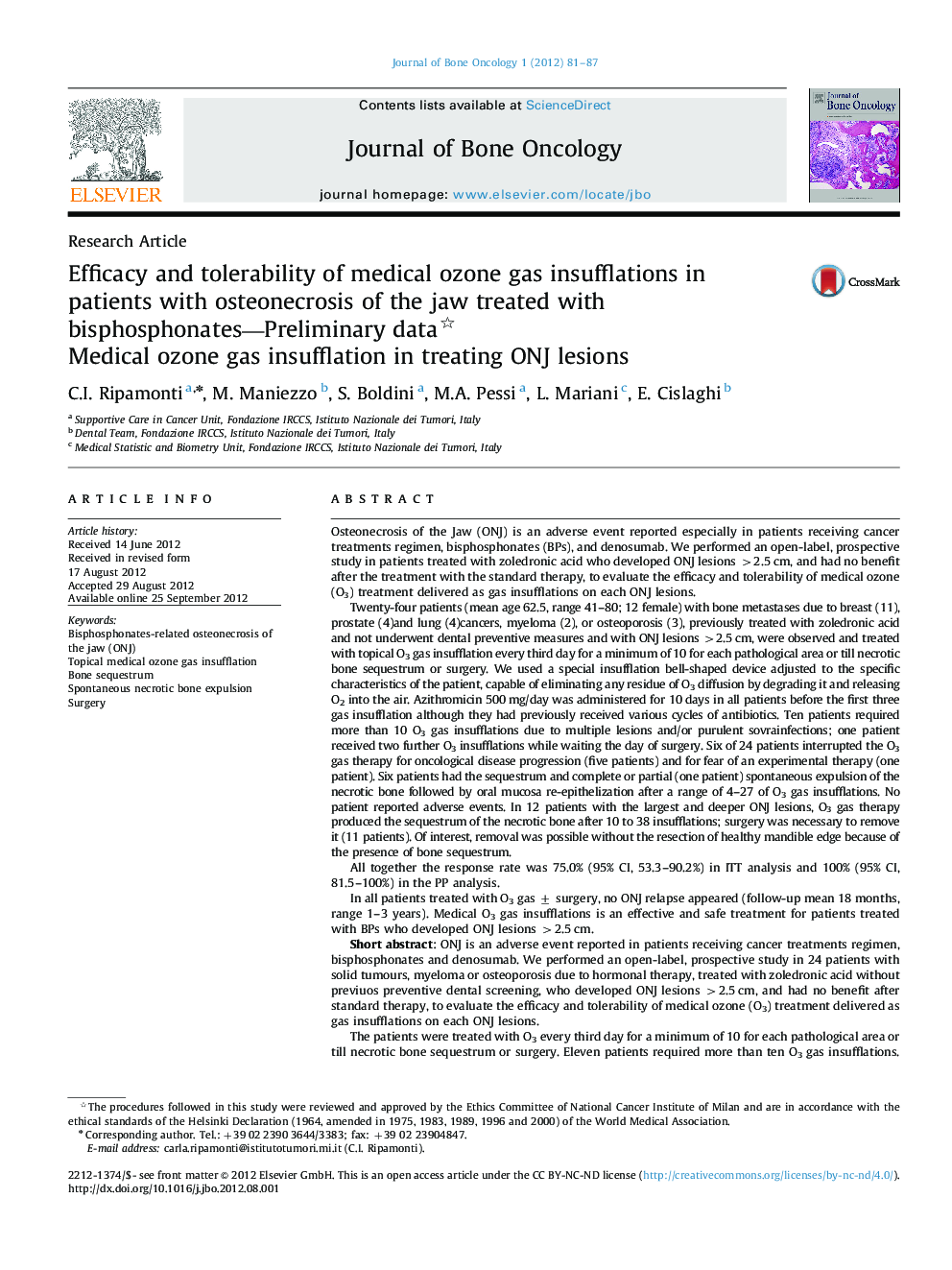| Article ID | Journal | Published Year | Pages | File Type |
|---|---|---|---|---|
| 2136123 | Journal of Bone Oncology | 2012 | 7 Pages |
Osteonecrosis of the Jaw (ONJ) is an adverse event reported especially in patients receiving cancer treatments regimen, bisphosphonates (BPs), and denosumab. We performed an open-label, prospective study in patients treated with zoledronic acid who developed ONJ lesions >2.5 cm, and had no benefit after the treatment with the standard therapy, to evaluate the efficacy and tolerability of medical ozone (O3) treatment delivered as gas insufflations on each ONJ lesions.Twenty-four patients (mean age 62.5, range 41–80; 12 female) with bone metastases due to breast (11), prostate (4)and lung (4)cancers, myeloma (2), or osteoporosis (3), previously treated with zoledronic acid and not underwent dental preventive measures and with ONJ lesions >2.5 cm, were observed and treated with topical O3 gas insufflation every third day for a minimum of 10 for each pathological area or till necrotic bone sequestrum or surgery. We used a special insufflation bell-shaped device adjusted to the specific characteristics of the patient, capable of eliminating any residue of O3 diffusion by degrading it and releasing O2 into the air. Azithromicin 500 mg/day was administered for 10 days in all patients before the first three gas insufflation although they had previously received various cycles of antibiotics. Ten patients required more than 10 O3 gas insufflations due to multiple lesions and/or purulent sovrainfections; one patient received two further O3 insufflations while waiting the day of surgery. Six of 24 patients interrupted the O3 gas therapy for oncological disease progression (five patients) and for fear of an experimental therapy (one patient). Six patients had the sequestrum and complete or partial (one patient) spontaneous expulsion of the necrotic bone followed by oral mucosa re-epithelization after a range of 4–27 of O3 gas insufflations. No patient reported adverse events. In 12 patients with the largest and deeper ONJ lesions, O3 gas therapy produced the sequestrum of the necrotic bone after 10 to 38 insufflations; surgery was necessary to remove it (11 patients). Of interest, removal was possible without the resection of healthy mandible edge because of the presence of bone sequestrum.All together the response rate was 75.0% (95% CI, 53.3–90.2%) in ITT analysis and 100% (95% CI, 81.5–100%) in the PP analysis.In all patients treated with O3 gas ± surgery, no ONJ relapse appeared (follow-up mean 18 months, range 1–3 years). Medical O3 gas insufflations is an effective and safe treatment for patients treated with BPs who developed ONJ lesions >2.5 cm.Short abstract: ONJ is an adverse event reported in patients receiving cancer treatments regimen, bisphosphonates and denosumab. We performed an open-label, prospective study in 24 patients with solid tumours, myeloma or osteoporosis due to hormonal therapy, treated with zoledronic acid without previuos preventive dental screening, who developed ONJ lesions >2.5 cm, and had no benefit after standard therapy, to evaluate the efficacy and tolerability of medical ozone (O3) treatment delivered as gas insufflations on each ONJ lesions.The patients were treated with O3 every third day for a minimum of 10 for each pathological area or till necrotic bone sequestrum or surgery. Eleven patients required more than ten O3 gas insufflations. Six of 24 patients interrupted the therapy for oncological disease progression. Six patients had the sequestrum and complete or partial (one patient) spontaneous expulsion of the necrotic bone followed by oral mucosa re-epithelization after a range of 4 to 27 of O3 gas insufflations. No patient reported adverse events. In 12 patients with the largest and deeper ONJ lesions, O3 gas therapy produced the sequestrum of the necrotic bone after 10 to 38 insufflations; surgery was necessary to remove it (11 patients). Of interest, removal was possible without the resection of healthy mandible edge because of the presence of bone sequestrum.All together the response rate was 75.0% (95% CI, 53.3–90.2%) in ITT analysis and 100% (95% CI, 81.5–100%) in the PP analysis.In all patients treated with O3 gas ± surgery, no ONJ relapse appeared (follow-up mean 18 months, range 1–3 years).
